The path to established major leaguer is a winding one, filled with hills, valleys, and unexpected detours for most young players. Even the most highly regarded, “can’t miss” top prospects can take some time before reaching the lofty heights expected of them.
That’s been the case for White Sox center fielder Luis Robert Jr.
Now, coming off an excellent 2023 campaign that saw him bash 38 homers and restore some of the shine to his former top prospect pedigree, it’s worth investigating the approach tweaks that he implemented and how much staying power they might have heading into 2024.
Getting Established
Robert Jr., you’ll undoubtedly recall, was a global consensus top 10 prospect (perhaps top 5) after the 2019 season when he slashed .328/.376/.624 with 108 runs scored, 32 home runs, and 36 stolen bases across three minor league levels. Robert’s excellent performance was all the more impressive given the context that he played only 50 rookie and A-ball games while battling injuries in 2018.
That stellar performance even prompted the rarely forward-thinking White Sox to secure Robert’s future services in a cost-controlled manner with a six-year, $50-million contract extension before he’d even seen a Major League pitch. At the time it was the largest pre-MLB debut deal ever signed.
Robert’s rookie debut during the 2020 COVID year was reasonable enough—league average offense (.233/.302/.436, 99 wRC+), with plus defense (+5 OAA) and baserunning (+1.7 BsR, 9 steals)—but also came with some warts. Robert’s approach at the plate was uber-aggressive (57.6% swing rate) and he chased (39.6%) and whiffed (41.5%) A LOT on the way to striking out in 32.2% of his plate appearances.
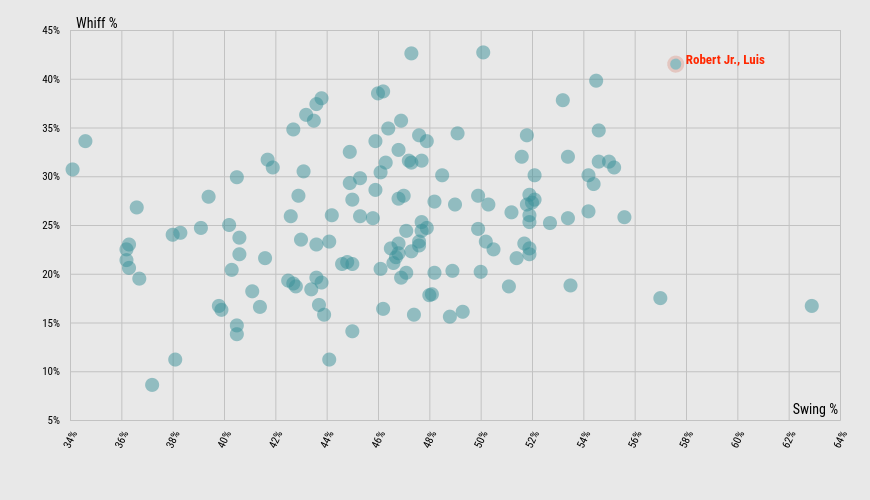
Scatterplot of Swing Rates and Whiff Rates, 2020 Season via Statcast
The next season started off promising with a 124 wRC+ in the season’s first month, with a reduced strikeout rate of 26.5%. But that progress was derailed by a bad hip flexor injury that kept Robert out of action until August. Upon his return, Robert absolutely mashed to the tune of .350/.389/.622 and 172 wRC+ thanks to another significant reduction in missed swings and strikeouts and a significant improvement in contact quality (as measured by exit velocity).
Those positive developments were enabled by a stance adjustment, which FanGraphs’ Luke Hooper detailed the following winter. Robert opened up his front side, progressively more and more as the end of the season went on (pictures included in the link above), and tweaked his two-strike approach with the express intent of making more contact.
It worked. Robert Jr.’s swinging strike rate cut down by about a third (21.5% to 14.2%) after the adjustment and he started crushing fastballs in a way that he never had at the big league level before. By season’s end, his strikeout rate was down to 20.6% and it appeared that Robert Jr. had closed a critical hole in his overall game. He was, as our Lucas Spence wrote that offseason, prepared for takeoff.
Not So Fast, My Friend
A myriad of injuries in 2022 put a damper on that excitement, however. Robert dealt with a groin injury, COVID-19, blurred vision, and a nagging wrist sprain that limited him to 98 games and a less exciting .284/.319/.426, 111 wRC+ line.
Although the injuries played a role, Robert’s lesser production also appeared to be driven by the stance and approach changes that fueled his breakout at the end of 2021.
Simply, Robert’s emphasis on making more contact was not paired with a similar improvement in plate discipline and selectivity. Robert’s adjustments allowed him to make more contact (up to 75.3% in 2022, from 61.4% in 2021), but he was also still the most aggressive swinger (61.7%) in the league among hitters with at least 400 plate appearances and he chased out of the zone at the 6th-highest rate (41.0%).
Although Robert maintained the reduced strikeout rate from 2021, his combination of aggression, chase, and improved contact skills contributed to a lot of low-quality contact. His exit velocity and launch angles fell and his ground ball rate spiked to 45.1%. As a result, Robert’s xwOBA on contact (xwOBAcon) fell from .449 and .466 in 2020 and 2021 to just .387 in 2022.
You can easily see in the heatmap comparison of Robert’s 2022 to 2021 that he hit the ball on the ground and to the opposite field significantly more often than he had just the season before:
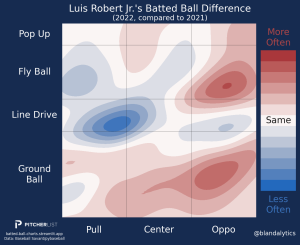
The drivers of that batted ball profile are evident in the zone heat maps below. You can see his swing aggression all over the zone (top left heatmap). It’s also very apparent that Robert made a lot of contact chasing down and away (bottom left), but it came with a lack of power in that part of the zone (bottom right).
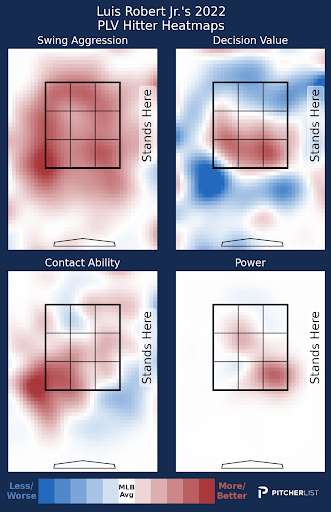
Reverting Back
In the FanGraphs scouting notes from Robert’s prospect days, some credit for his outstanding 2019 minor league campaign was given to some mechanical adjustments that kept his front side closed a little longer and enabled him to go from ground ball rates in the mid-40s in 2018 to the upper-20s/low-30s in 2019.
Last season, when Robert burst back onto the star scene with a .264/.315/.542, 128 wRC+, 38 home run campaign, he ditched the wide-open stance that he’d used in 2021 and 2022 and started to close back up. Malachi Hayes detailed Robert’s adjustments and results well for South Side Sox back in July 2023.
Most notable from this was that Robert now could pull fly balls and line drives at a career-best rate, and far more often than he did in 2022:
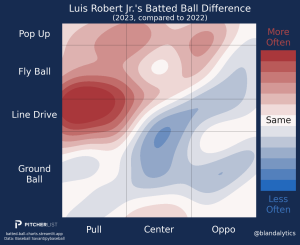
Robert had 53 hard hit (95+ mph exit velocity) and pulled fly balls or line drives in 2023, which made up about 14.1% of his batted balls. His previous seasonal high had been about 13.8% in his excellent 2021 season but was 8.8% in 2022.
The adjustments Robert implemented also made it so he could cover the plate with authority, as we can see in his zone heat maps (particularly pay attention to where his power was concentrated down and away, compared to the same charts from 2022 above):
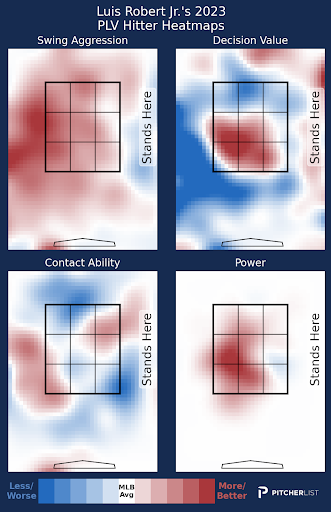
With the new pull-oriented approach (even on pitches away from him, as Hayes showed), Robert traded away some of the contact frequency and strikeout suppression that he gained in the past. His overall swing aggression and plate discipline remained more or less at the same levels as in the past, and he saw his whiff rate and strike-out rates increase by about 6 points (to 33.5%) and 9 points (to 28.5%), respectively.
Just like in 2019 in the minor leagues, those appear to be trades that were well worth making.
Now the question heading into 2024 is if this approach change is sustainable.
How sticky are hard-hit, pulled fly balls?
It’s well-established and understood that fly balls and line drives to hitters’ pull sides are by far the most productive batted balls they can produce. Here are the league’s results by batted ball type and direction in the Statcast era:
In early 2020, our Dan Richards published a study that investigated the season-to-season repeatability of hard-hit, pulled fly balls at a player level. The whole piece is well worth your time, especially given the prevalence of discourse this offseason about spray angle and pulling fly balls (i.e., about Isaac Paredes and Cody Bellinger, among others), but Dan’s takeaway was that hard hit pulled fly balls are only marginally sticky from year to year.
He found that one season’s hard hit pulled fly ball rates explained (or, “predicted”) about 32% of the next year’s hard hit, pulled fly ball rates.
What’s more, and particularly concerning for Luis Robert Jr.’s outlook in 2024 is that the batters in Dan’s study that produced their peak hard hit, pulled fly ball rates in a season, almost uniformly saw a substantial decrease the following season. For the players in the sample with other strong peripheral skills, as Max Muncy drawing walks for on-base percentage, they were able to maintain high rates of overall production. But for players that were singularly reliant on smashing batted balls to their pull side, like Brian Dozier, they experienced significant regression.
(I should note that Richards’ findings here added to and aligned with those of our Nick Gerli from mid-2019, as well.)
Conclusion
Does this then mean that we should be worried about significant regression for Robert Jr. in 2024? I think the answer is yes and no. History suggests it’s unlikely that he’ll repeat his pulled fly ball dominance to the same degree next season. And he still has all the same swing aggression and lack of plate discipline risk factors that have been present for his whole career. At the same time, those risks are counterbalanced by the fact that he’s clearly demonstrated the ability to adapt and implement adjustments, and he’s still young and uber-talented.
In the end, I don’t think we should view Robert Jr. as having finally “put it all together” based on his strong 2023. He’s still a work in progress who’s made some important growth steps and who still has some important weaknesses. For a now 26-year-old former top prospect who still has a very encouraging future outlook, there’s nothing wrong with that.

